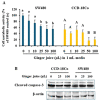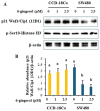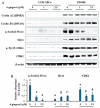Ginger Root Bioactive Compounds Specifically Inhibits Growth of Colon Cancer Cells in Culture
- PMID: 38756503
- PMCID: PMC11097737
- DOI: 10.1177/11786388241231163
Ginger Root Bioactive Compounds Specifically Inhibits Growth of Colon Cancer Cells in Culture
Abstract
Objective: Colon cancer is affluent among many people, and having cancer greatly impacts the lives of many. Ginger is a common food, particularly in Asian cuisine. However, the health benefits of ginger as a whole food and 6-gingerol, its bioactive compound in prevention of colon cancer have not been fully addressed. This experiment investigated effects of ginger juice and 6-gingerol on colon cancer cell growth and death.
Methods: Fresh ginger roots were homogenized for juice preparation. Total phenolic contents of ginger juice were measured using Folin-C assay. Colon cancer SW480 cells and normal colon epithelial cells CCD-18Co were treated with ginger juice and/or 6-gingerol. Cell metabolic activity was assessed by MTT assay. Cell apoptosis and cell cycle arrest were accessed by immunoblotting. Data were analyzed by 2-way ANOVA with a Tukey post-hoc test and statistical significance was set at P < .05.
Results: The results showed that ginger juice selectively inhibited SW480 cell growth at 25 µL/mL for 40 hours. High doses of ginger juice (at 50 and 100 µL/mL for 40 hours) inhibited the growth of both cell types. This was independent of caspase-3 activation. Six-gingerol specifically inhibited SW480 cell growth starting at 0.5 µmoL/L (P < .01). More than 1 µmoL/L 6-gingerol did not give more power to inhibit SW480 cell growth. The results also showed that CCD-18Co cell growth rates were not changed after 6-gingerol treatments (up to 10 µmoL/L, P > .1). Immunoblotting results revealed that the elevation of Myt1 levels and decreases in CDK1, p21 Wafl/Cip1 and pSer642-Wee1 only occurred in SW480 but not CCD-18Co cells when treated with 1 and/or 2.5 µmoL/L 6-gingerol for 40 hours.
Conclusion: 6-gingerol can specifically inhibit SW480 cancer cells without killing normal CCd-18Co cells, through cell cycle arrest. Ginger juice can selectively inhibit colon cancer cell growth in a narrow window at ~25 µL/mL.
Keywords: 6-Gingerol; apoptosis; cell cycle arrest; colorectal cancer; epithelial cell; phenol.
© The Author(s) 2024.
Conflict of interest statement
The author(s) declared no potential conflicts of interest with respect to the research, authorship, and/or publication of this article.
Figures




Similar articles
-
[10]-Gingerol, a major phenolic constituent of ginger root, induces cell cycle arrest and apoptosis in triple-negative breast cancer cells.Exp Mol Pathol. 2017 Apr;102(2):370-376. doi: 10.1016/j.yexmp.2017.03.006. Epub 2017 Mar 16. Exp Mol Pathol. 2017. PMID: 28315687
-
[Freeze drying process optimization of ginger juice-adjuvant for Chinese materia medica processing and stability of freeze-dried ginger juice powder].Zhongguo Zhong Yao Za Zhi. 2018 Feb;43(3):520-526. doi: 10.19540/j.cnki.cjcmm.20171208.008. Zhongguo Zhong Yao Za Zhi. 2018. PMID: 29600616 Chinese.
-
6-Gingerol Inhibits Growth of Colon Cancer Cell LoVo via Induction of G2/M Arrest.Evid Based Complement Alternat Med. 2012;2012:326096. doi: 10.1155/2012/326096. Epub 2012 Jun 7. Evid Based Complement Alternat Med. 2012. PMID: 22719783 Free PMC article.
-
Protective and therapeutic potential of ginger (Zingiber officinale) extract and [6]-gingerol in cancer: A comprehensive review.Phytother Res. 2018 Oct;32(10):1885-1907. doi: 10.1002/ptr.6134. Epub 2018 Jul 16. Phytother Res. 2018. PMID: 30009484 Review.
-
Ginger potency on the prevention and treatment of breast cancer.Breast Dis. 2023;42(1):207-212. doi: 10.3233/BD-239003. Breast Dis. 2023. PMID: 37424457 Review.
References
-
- American Cancer Society, Key Statistics for Colorectal Cancer. 2024. https://www.cancer.org/cancer/types/colon-rectal-cancer/about/key-statis...
-
- Willett W. The search for the causes of breast and colon cancer. Nature. 1989;338:389-394. - PubMed
-
- Solomon E, Borrow J, Goddard AD. Chromosome aberrations and cancer. Science. 1991;254:1153-1160. - PubMed
-
- Medema JP, Vermeulen L. Microenvironmental regulation of stem cells in intestinal homeostasis and cancer. Nature. 2011;474:318-326. - PubMed
-
- Aune D, Lau R, Chan DS, et al.. Nonlinear reduction in risk for colorectal cancer by fruit and vegetable intake based on meta-analysis of prospective studies. Gastroenterology. 2011;141:106-118. - PubMed
LinkOut - more resources
Full Text Sources
Research Materials
Miscellaneous

